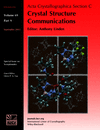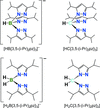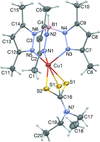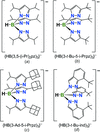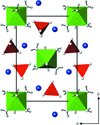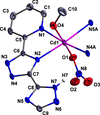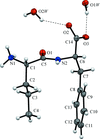issue contents
September 2013 issue
Special issue on Scorpionates
Guest Editor: Glenn P. A. Yap (Department of Chemistry & Biochemistry, University of Delaware, USA)

Cover illustration: For details of the cover image for this special issue on Scorpionates, see the Editorial by Guest Editor Glenn P. A. Yap [Acta Cryst. (2013), C69, 937-938].
editorial
Free 

scorpionates
Download citation


Download citation


In the presence of difluoromethane in pentane solvent, the scorpionate complex Tp′Rh[P(OMe)3](Me)H loses methane to give a product in which the phosphine O—Me bond is cleaved.
Download citation


Download citation


The title triphenylphosphane copper(I) complex, incorporating a bis(3,5-diisopropylpyrazol-1-yl)dihydroborate scorpionate ligand, was characterized by X-ray crystallographic analysis. The electron density of the CuI ion is discussed and compared to a series of analogous triphenylphosphane complexes.
Download citation


Download citation


Improved syntheses and electronic characterization of carboxamide-substituted tris(pyrazolyl)borate ligands are reported. Their TlI salts and the CuI carbonyl complexes have been prepared and are compared with alkyl-substituted tris(pyrazolyl)borate ligands.
Download citation


Download citation


Complexes of the linear C C—Au—C C unit functionalized with tris(pyrazolyl)methane and 1,8-naphthalimide groups have been prepared and structurally characterized.
Download citation


Download citation


[H2B{3,5-(CF3)2pz}2]Tl has a two coordinate thallium atom with a bent geometry and boat-shaped bis(pyrazolyl)borate ligand. The related tris(pyrazolyl)borate analogue [HB{3,5-(CF3)2pz}3]Tl has a trigonal pyramidal thallium atom.
Download citation


Download citation


Tris(pyrazolyl)hydroborate ligation has been used to isolate trivalent gallium hydride and monovalent indium complexes, namely {[TpBut,Me]GaH}[GaCl4], [TpMe2]In and [TpBut,Me]In, which have been structurally characterized by single-crystal X-ray diffraction.
Download citation


Download citation


One electron oxidation of a four-coordinate tris(carbene)borate cobalt(II) azide complex yields a five-coordinate cobalt(III) bis(azide).
Download citation


Download citation


A low-resolution X-ray molecular study shows that the title compound displays scorpionate character, and resolves apparent ambiguities between solution and solid-state NMR spectroscopies.
Download citation


Download citation


This new complex using the classic TpMe2 scorpionate, (TpMe2)Cu(S2CNEt2), is relevant to blue copper protein models and to Cu extraction from waste treatment and mine-tailing leachate. The IR and UV–Vis spectra are consistent with the crystal structure.
Download citation


Download citation


The heteroscorpionate bis(3,5-di-tert-butylpyrazol-1-yl)dithioacetate ligand has been synthesised by reacting bis(3,5-di-tert-butylpyrazol-1-yl)methane with n-BuLi and CS2. A zinc chloride complex bearing this ligand exhibits κ3N,N′,S-coordination and resembles the active site of zinc-containing peptide deformylases (PDFs).
Download citation


Download citation


A comparison is made of the thallium(I) complex of the `most hindered' tris(3-adamantyl-5-isopropylpyrazol-1-yl)hydroborate ligand and that of the `super-hindered' tris(7-tert-butylindazol-2-yl)hydroborate ligand
inorganic compounds
Download citation


Download citation


Rerefinements based on the original data as well as crystal–chemical considerations make it most likely that the reported Tutton salts with formula types [M(H2O)6](ClO4)2(H2O)2 and Na2M(SO4)2(H2O)6 (M is a first row transition metal) do not exist.
Download citation


Download citation


The crystal structures of three alkali tetragermanates A2Ge4O9 (A = Na, K and Rb) are trigonal (space group P c1). The main building units are a three-membered ring of tetrahedra, oriented within the (001) plane and forming tetrahedral sheets. These sheets are connected to each other by two different regular isolated GeO6 octahedra via corner-sharing to build up a tetrahedral–octahedral framework.
c1). The main building units are a three-membered ring of tetrahedra, oriented within the (001) plane and forming tetrahedral sheets. These sheets are connected to each other by two different regular isolated GeO6 octahedra via corner-sharing to build up a tetrahedral–octahedral framework.
Download citation


Download citation


The structural study of the title compound is based on low-temperature data and the calculated PDF has been used for local structural analysis. The crystal structure is characterized by a network of [NdCl2(H2O)6]+ cations with distorted square-antiprism geometry, connected by O—H⋯Cl intermolecular interactions.
metal-organic compounds
Download citation


Download citation


Single-crystal structural analysis reveals that the title complex is a one-dimensional polymeric chain, which is further extended to a three-dimensional supramolecular network via a combination of hydrogen-bonding and aromatic stacking interactions.
Download citation


Download citation


The title compound crystallizes in the space group P with Z = 4. The crystal is stabilized by π–π interactions and weak C—H⋯I interactions. Different intermolecular interactions distinguish the two independent molecules of the asymmetric unit.
with Z = 4. The crystal is stabilized by π–π interactions and weak C—H⋯I interactions. Different intermolecular interactions distinguish the two independent molecules of the asymmetric unit.
Download citation


Download citation


Six-coordinate tin–tetra(4-iodophenyl)porphyrins self-assemble into halogen-bonded tetragonal networks, exhibiting a unique rectangular pattern of interporphyrin I⋯I interactions.
Download citation


Download citation


In CuI and AgI ladder-like coordination polymers, two metal ions are linked by two 2-ethyl-1-(pyridin-3-ylmethyl)-1H-benzimidazole ligands (bep) to form a centrosymmetric 18-membered M2(bep)2 metallacycle, while adjacent M2(bep)2 metallacycles are further interlinked by another two bep ligands resulting in a ladder-like array.
Download citation


Download citation


The structure of a nickel compound with a three-dimensional polycatenation framework formed by intermolecular hydrogen bonds and interlocking interactions is reported.
Download citation


Download citation


In a novel Cu–Na heteronuclear three-dimensional coordination polymer, the carboxylate groups of iminodiacetate (ida) ligands act as bridges and connect [Cu(ida)] and [Cu(ida)2] building blocks in a 2:1 ratio, forming two-dimensional arrays. These layers are interconnected into a three-dimensional structure by sodium ions.
Download citation


Download citation


The structure of a title novel one-dimensional ABX3-type organic–inorganic hybrid complex consists of benzyltriethylammonium cations and one-dimensional anionic {[CdCl3]−}n chains, in which the CdII centres are in an unusual two-layer five-coordinated arrangement.
organic compounds
Download citation


Download citation


The cocrystal of 5-(4-bromophenyl)-1,3,4-thiadiazol-2-amine with 2-(naphthalen-2-yloxy)acetic acid is a 1:1 adduct, while with 3,5-dinitrobenzoic acid is a salt. In the adduct, hydrogen bonding gives a one-dimensional chain structure, and in the salt, a discrete centrosymmetric heterotetramer is formed
Download citation


Download citation


An unexpected but high-yield reaction product forms sheets of π-stacked hydrogen-bonded dimers.
Download citation


Download citation


The central C—C—C angle is 120.3 (2)° and the molecules are linked by N—H⋯O hydrogen bonds into a ribbon containing edge-fused S(8) and  (8) rings.
(8) rings.
Download citation


Download citation


Comparisons are made of the title compound to the internal linkage conformations in the two crystallographic forms of the structurally related disaccharide, methyl β-D-mannopyranosyl-(1→4)-β-D-xylopyranoside).
Download citation


Download citation


This is the most sterically congested triarylphosphonium salt yet to be reported and has a `propeller' arrangement of the three 2,4,6-triisopropylphenyl groups around the P atom, with the protonation site located along the molecular threefold axis. There are short P⋯H contacts between the flanking isopropyl methine H atoms and the P atom.
Download citation


Download citation


Comparison of the newly determined serotonin salt, serotonin adipate, with previously known salts demonstrates that the conformation of the biologically active component can be modified by altering the counter-ion.
Download citation


Download citation


The crystal structure of bridged neoglycoside, 1-deoxy-1-[(methoxy)methylamino)]-2,5-di-O-triethylsilyl-β-D-glucofuranurono-γ-lactone revealed a 1T2-like conformation is preferred for the furanoid ring, while the γ-lactone system adopts an E4 conformation. This structure supports the properties associated with the anomeric effect for furanosides.
Download citation


Download citation


The title dipeptide has a nonproteinogenic N-terminal residue. The crystal structure is divided into distinct hydrophobic and hydrophilic layers, the latter encompassing cocrystallized water molecules connecting the charged N- and C-terminal groups.
Download citation


Download citation


The title compound was synthesized in high yield by a three-component Kabachnik–Fields reaction. It precipitates as racemic crystals in which strong hydrogen bonds between the hydroxy group and the P=O group of a neighbouring molecule form one-dimensional heterochiral chains.
Download citation


Download citation


Two basic heterocyclic imino structures display a planar backbone with similar features, but differ in the heterocyclic atoms located in the five-membered rings, i.e. N and S. In the pyrrole, centrosymmetric iminopyrrole dimers are assembled by means of two inverted N—H⋯N hydrogen bonds and two inverted C—H⋯π interactions. In the thiophene, however, molecules are linked by nonclassical C—H⋯N hydrogen bonds in which the molecules play the roles of both hydrogen-bond donors and acceptors, resulting in one-dimensional supramolecular chains.
Download citation


Download citation


While the crystal structure of tricyclic acyclovir dihydrate containing an (H2O)8 solvent water molecule cluster has been described previously, the disorder was incompletely modeled. In this work, the disorder model is extended and includes disorder of one tricyclic acyclovir hydroxy group across an inversion centre, leading to characterization of a concerted chain of O—H⋯O hydrogen bonds constituting a `proton-wire' structure.
Download citation


Download citation


Hydrogen-bonded sheets of organic molecules are linked into a three-dimensional layer structure by cyclic centrosymmetric water tetramers.


 journal menu
journal menu








